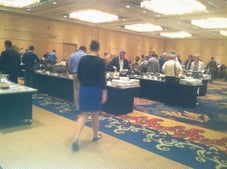 As any conference-goer can attest, the shortest distance between two points is not a straight line when that line is the lunch line. At Lean conferences like the ones I attend it’s especially incongruous to hear stories all morning about customer service and flow, and then later stand in a long line at the lunch buffet. (I confess, I’m not sure if I should be classified as the customer waiting for service, or inventory in queue before the serving process. Can someone please help me clear up my role in that scenario?)
As any conference-goer can attest, the shortest distance between two points is not a straight line when that line is the lunch line. At Lean conferences like the ones I attend it’s especially incongruous to hear stories all morning about customer service and flow, and then later stand in a long line at the lunch buffet. (I confess, I’m not sure if I should be classified as the customer waiting for service, or inventory in queue before the serving process. Can someone please help me clear up my role in that scenario?)
In this context, the recent LEI Transformation Summit in Orlando was noteworthy not only for its excellent theme, speakers and learning sessions, but also for its luncheon arrangements. On day one of the conference, I entered the dining room with the expectation that there would be iPhone time – time for emails and maybe a game of Words With Friends – while I stood in the lunch queue. But there were no lines. No waiting. I watched intently as conference-goers streamed into the dining room and, hardly breaking stride, moved through one of four double-sided serving lines.
After lunch I asked Rachel Regan, LEI’s conference organizer, how they managed to avoid lines. “Do you have a system?” I asked. “Yes,” she replied, “we have a rule of thumb: one two-sided table for every hundred attendees.” She added, “We also try to choose meals that don’t require too much assembly, like sandwiches, because that can cause delays, and we keep the serving tables close together so there’s a better distribution of flow. The hotels like to spread the tables out, but people then tend to flock to the nearest table. And we make sure that food is replenished frequently to avoid a line stop.” Rachel thought for a moment and finally offered, “To be honest, we also had a little luck today because one of plenary sessions before lunch ended a little early and the other a little late, so this staggered the groups at the lunch line.”
I thanked Rachel for sharing her thoughts about the lunch line standardized work. I thought to myself, “TPS works everywhere.”
This could have been the end of my post, but as luck would have it, the second day of LEI’s conference was opened by Jamie Bonini of TSSC co-presenting with Margarette Purvis, CEO of the New York City Food Bank and perhaps the most eloquent and passionate Lean advocate that I have heard in many years. Her challenge: to reduce hours of waiting for food at their pantries. Bear in mind, these are not queues of over-stuffed conference-goers like me waiting in a warm conference center. The pantry serves persons with a critical need for nourishment, who stand in the cold, waiting to feed their families. The pantries are their lifelines. And as Ms. Purvis put it, “ They should not suffer the indignity of waiting for hours in line for a meal.” Enter TSSC with an offer to help eliminate the pantry lines. This compelling example of TPS employed for the public good is documented in the following link--- many small changes for the better that came from the dedication of the NYC Food Bank staff under the generous guidance of TSSC. I encourage you to take a couple minutes to study it: http://www.tssc.com/nfp-fbny.asp. I thought to myself once again, “TPS works everywhere.”
Do you have a unique application of TPS that you would like to share? Please comment.
O.L.D.
BTW: Speaking of conferences, don’t miss the upcoming 26th Internatinoal Shingo Conference, May 5-9 in Sandusky, Ohio. I’ll be there and hope to see you too.

